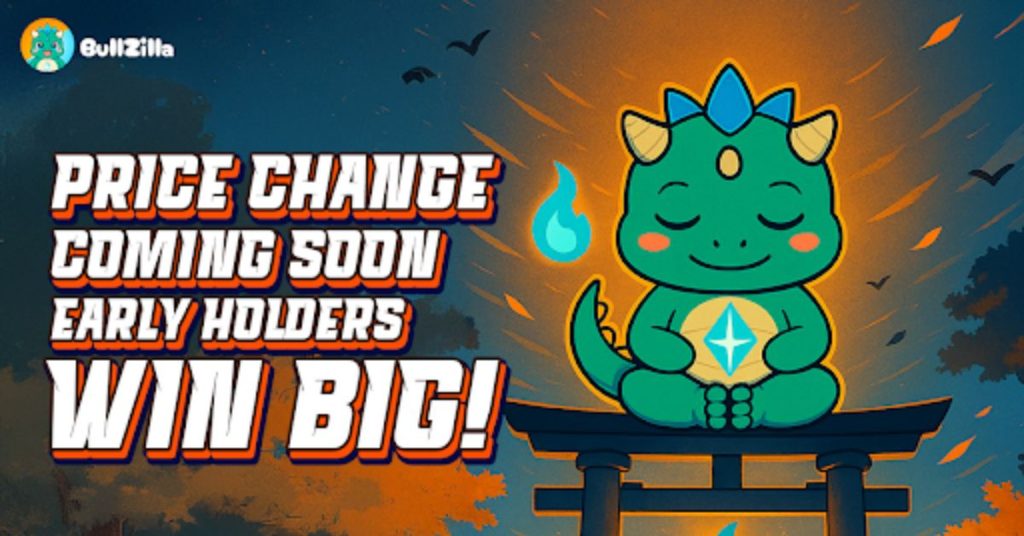BullZilla Raised $10,000 Within 50 minutes After Presale Launch, Best Meme Coin Presale With 100x Potential, as MEW and PNUT Rally

The post BullZilla Raised $10,000 Within 50 minutes After Presale Launch, Best Meme Coin Presale With 100x Potential, as MEW and PNUT Rally appeared first on Coinpedia Fintech News
Every bull market breeds new legends, but 2025’s stories are being written faster than most expected. Bull Zilla has already cemented itself as one of the best meme coin presales with 100x potential, selling more than 7 billion tokens within its first 24 hours and raising over $39,000 in Stage 1. Now priced at $0.00001242 in Stage 1, Phase 2, this Ethereum-based meme token is redefining how presales should work, while competitors like Cat in a Dog’s World and Peanut the Squirrel face sharper swings in sentiment.
The presale frenzy is not just about hype. It is about mechanics, conviction, and reward systems that create long-term belief. BullZilla’s progressive pricing, staking incentives, and live burn mechanisms are already putting it in a category of its own.
BullZilla’s HODL Furnace: Forging Value Through Staking
BullZilla’s ($BZIL) narrative is built not just on roaring branding but on solid tokenomics. Its progressive price engine ensures that every $100,000 raised or every 48 hours pushes the token price higher. This system rewards early conviction and builds a natural scarcity curve into the presale itself.

Yet the standout feature driving attention is the HODL Furnace. Investors staking their tokens here can earn up to 70% APY. To put that in perspective, Ethereum’s proof-of-stake system yields between 4–7% depending on validator activity (Ethereum.org, 2023). BullZilla’s staking design is a deliberate attempt to convert passive speculation into structured, compounding rewards.
This presale model resonates with analysts because it connects narrative to economics. Selling 7 billion tokens in one day demonstrates early conviction, but the Furnace ensures those tokens are not simply flipped. Instead, they are locked into a system that incentivizes holding. For investors seeking the best meme coin presales with 100x potential, this duality of hype and mechanics positions BullZilla as a front-runner.
The ROI projections reinforce the opportunity. A allocation of 644 million tokens could yield millions if the coin reaches even modest listing targets such as $0.01 or $0.05. Such asymmetry is rare in today’s market, where most established meme tokens already trade at diluted valuations.
Cat in a Dog’s World: A Unique Narrative With Uneven Execution
Cat in a Dog’s World has become one of the more creative entrants in the meme coin arena. Its narrative of feline rebellion against canine dominance has resonated with a niche audience, giving it virality across certain crypto communities. However, its momentum has faced challenges.
According to Messari research, projects with strong branding but limited token utility often struggle to sustain growth after initial hype cycles. Cat in a Dog’s World reflects this reality. While early investors have enjoyed surges, recent volatility has underscored the difficulty of converting narrative into long-term economic strength.
That said, its creative edge should not be dismissed. Meme coins live and die on stories, and this project has demonstrated it can capture attention. Yet for those focused on ROI potential, Cat in a Dog’s World lacks the structural scaffolding of projects like BullZilla. The absence of mechanisms such as staking, burns, or progressive pricing means it leans heavily on virality. Compared with the best meme coin presales with 100x potential, its upside looks more limited.
Peanut the Squirrel: A Viral Hit Learning the Hard Way
Peanut the Squirrel entered the meme coin market with humor and meme culture at its core. Its branding tapped into internet nostalgia, and like many viral coins, it enjoyed a quick burst of momentum. Yet, as Chainalysis data shows, viral meme tokens often experience liquidity cliffs once social traction slows.
Peanut has been no exception. While its community remains active, its trading volume and price action have shown sharp corrections. This volatility highlights the challenge of sustaining viral momentum without embedding structural incentives for holders. Investors chasing the best meme coin presales with 100x potential will find Peanut engaging but risky, given its reliance on pure virality rather than engineered scarcity.
Peanut still has a path to relevance if it evolves its ecosystem and adds features such as staking or deflationary mechanics. Until then, it remains a speculative play that lacks the robustness of structured presales like BullZilla’s.
Now consider the ROI math with a $2K investment at Stage 1, Phase 2 pricing. At $0.00001242, that allocation would secure roughly 161 billion $BZIL tokens. If the token reaches just $0.001 after launch, that bag could be worth about $161 million. Even at a conservative $0.01 target, the same $2K grows into over $1.6 billion. This type of asymmetry is why presales have historically outperformed secondary market entries and why BullZilla stands out among the best meme coin presales with 100x potential.

ROI Potential: Why BullZilla Stands Apart
| Investment | Presale Entry | Tokens Purchased | Target Price | Portfolio Value | ROI Multiple |
| $2,000 | $0.00001242 | ~161,000,000,000 | $0.001 | $161,000,000 | ~80,000x |
| $2,000 | $0.00001242 | ~161,000,000,000 | $0.01 | $1,610,000,000 | ~800,000x |
| $2,000 | $0.00001242 | ~161,000,000,000 | $0.05 | $8,050,000,000 | ~4,000,000x |
Conclusion
BullZilla’s presale has already set a tone for 2025. Selling 7 billion tokens in its first 24 hours and raising $39,000 in Stage 1, it has now advanced to Phase 2 at $0.00001242. Its progressive price engine, 70% APY staking rewards, and live burn mechanics establish it as one of the best meme coin presales with 100x potential.
Meanwhile, Cat in a Dog’s World entertains with narrative flair but lacks structural depth, and Peanut the Squirrel underscores the fragility of meme coins built on virality alone. For blockchain developers, financial analysts, and meme coin enthusiasts, the takeaway is clear: the next generation of meme coins will not be defined by hype alone but by how well they weave economics into the story.
BullZilla represents that evolution, bridging mythic branding with hardcoded scarcity and yield. In the hunt for the best meme coin presales with 100x potential, BullZilla is leading the charge.

For More Information:
BZIL Official Website
Join BZIL Telegram Channel
Follow BZIL on X (Formerly Twitter)
Frequently Asked Questions
How many tokens did BullZilla sell in the first 24 hours?
More than 7 billion tokens.
What is the current BullZilla presale price?
Stage 1, Phase 2 tokens are priced at $0.00001242.
Why is BullZilla considered one of the best meme coin presales with 100x potential?
Its progressive pricing, staking rewards, and scarcity-driven mechanics create exponential ROI opportunities.
How does Cat in a Dog’s World compare?
It has strong narrative appeal but lacks deeper tokenomics for sustained growth.
What risks are tied to Peanut the Squirrel?
Its reliance on virality makes it fragile without additional economic features.
Glossary of Terms
APY: Annual percentage yield from staking.
Burn Mechanism: Permanent removal of tokens from circulation.
Presale Stage: Early fundraising round before exchange listings.
ROI: Return on investment.
Liquidity: Ease of trading an asset without impacting its price.
Tokenomics: Economic design of a crypto asset.
Volatility: Frequency and scale of price fluctuations.
MiCA: EU framework for regulating crypto assets.
Smart Contract: Automated blockchain code enforcing rules.
Deflationary Mechanism: Tokenomics reducing supply over time.
You May Also Like

US Spot ETH ETFs Witness Remarkable $244M Inflow Surge

First Ethereum Treasury Firm Sells ETH For Buybacks: Death Spiral Incoming?

